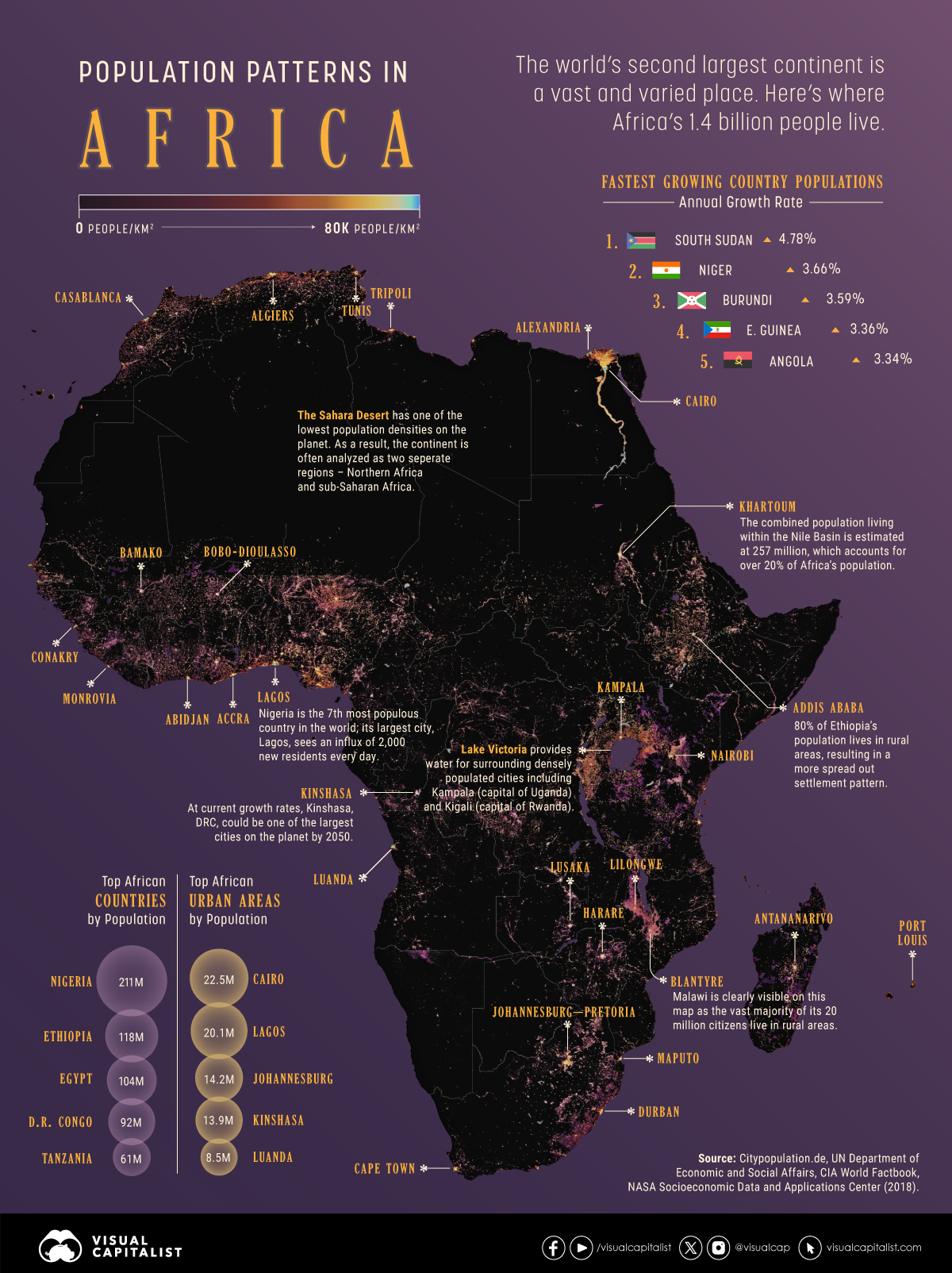Africa, the world’s second largest continent, spans over 30 million km2, home to the not only world’s biggest desert but also the second-largest tropical rainforest, and of course, approximately 1.4 billion people.In this infographic, we map out the continent’s population density patterns. It’s a prime example of how humans congregate near fresh water and around the edges of natural obstacles.
This population density data comes from the Gridded Population of the World dataset created by the Center for International Earth Science Information Network (CIESIN) hosted by NASA’s Socioeconomic Data and Applications Center (SEDAC).
Ranked: Most Populous African Countries
Africa’s second largest economy, Nigeria, is also its most populous: more than 220 million people live in this diverse West African country with 250 ethnic groups, speaking over 500 different languages.
And the nation is only growing. By 2100, it’s estimated that the Nigerian population could be more than three-fold its current size, at nearly 800 million residents, becoming the second-most populous country in the world.
Rank Country Population 1 ?? Nigeria 224M 2 ?? Ethiopia 127M 3 ?? Egypt 112M 4 ?? DRC 102M 5 ?? Tanzania 67M 6 ?? South Africa 59M 7 ?? Kenya 55M 8 ?? Uganda 49M 9 ?? Sudan 48M 10 ?? Algeria 46M Source: UN Department of Economic and Social Affairs, World Population Prospects. (2022)Across the continent, along its eastern side, Ethiopia, is the second-most populous country on the continent. Unlike Nigeria—which has nearly 20 cities with at least half a million residents—more than three-quarters of Ethiopia’s 127 million people live in rural communities.
Ranked third, Egypt (112 million) is the only North African country in the top five by population. The Democratic Republic of the Congo (DRC) comes in fourth (102 million), with Tanzania (67 million) rounding out the top five.
Ranked: Fastest Growing African Countries By Population
In the year 1900, Africa accounted for 9% of the world’s population. Currently its share stands close to 18%. By 2025, the International Monetary Fund (IMF) expects one in four people in the world to live in Africa, and says the continent’s demographic transition has the power to “transform the world.”
The most populous African countries (DRC, Tanzania, Ethiopia, Nigeria, and Egypt) will contribute the lion’s share to this growth of course, but within the continent, other countries are also seeing relatively rapid population growth.
Rank Country Growth Rate 1 ?? South Sudan 4.78% 2 ?? Niger 3.66% 3 ?? Burundi 3.59% 4 ?? Equatorial Guinea 3.36% 5 ?? Angola 3.34% 6 ?? Benin 3.31% 7 ?? Uganda 3.22% 8 ?? DRC 3.13% 9 ?? Chad 3.05% 10 ?? Mali 2.93% Source: CIA World Factbook.In South Sudan, the world’s newest country, the population is growing at nearly 5% every year. The broader sub-Saharan population meanwhile is growing at half that rate. Aside from a higher fertility rate, the country is also seeing an influx of refugees from conflict areas in neighboring Sudan.
While no other African nation is quite matching South Sudan’s population growth, several of Africa’s poorer economies are also posting an annual population increase of more than 3% including Niger, Burundi, and Chad.
Ranked: Most Populous African Cities
About half of Africa lives in urban areas, which is less than the global average of 57%. The 10 most populous cities on the continent together account for about 115 million people, more than 1.5x the UK’s total population.
Egypt’s capital, Cairo, built along the banks of the Nile, is home to more than 22 million residents, and ranks as Africa’s largest city. This bustling metropolis has stood as an important trade juncture between continents for more than 1,400 years—and is still somehow one of Egypt’s younger cities.
Rank City Country Population 1 Cairo ?? Egypt 22.2M 2 Lagos ?? Nigeria 21.4M 3 Kinshasa ?? DRC 15.0M 4 Johannesburg ?? South Africa 14.8M 5 Luanda ?? Angola 9.0M 6 Khartoum ?? Sudan 6.9M 7 Abidjan ?? Cote d’Ivoire 6.6M 8 Nairobi ?? Kenya 6.6M 9 Accra ?? Ghana 6.4M 10 Dar es Salaam ?? Tanzania 6.0M Source: Urban agglomerates (2023) Citypopulation.de.Down south, across the Sahara desert, and near the shores of the Atlantic, Nigeria’s former capital Lagos has slightly more than 21 million people. The city’s name comes from the numerous surrounding lagoons, and its original name in Yoruba, “Eko”, also means “lake.” Population estimates for the city are often disputed because of several different administrative regions, but also because of how fast Lagos is growing: it’s estimated 2,000 new residents move in every day.
Kinshasa, the capital of the DRC ranks third with about 15 million residents, and is slated to become the fourth largest city in the world, with 35 million people, by 2050.
Johannesburg, South Africa (15 million), and Luanda, Angola (9 million) round out the top five most populous African cities.
Mapped: Africa’s Population Density Patterns
February 7th, 2024
February 7th, 2024
Via Visual Capitalist, an interesting graphical look at Africa’s population density patterns:
This entry was posted on Wednesday, February 7th, 2024 at 2:24 am and is filed under Uncategorized. You can follow any responses to this entry through the RSS 2.0 feed.
Both comments and pings are currently closed.
ABOUT
Focusing primarily on The New Seven Sisters - the largely state owned petroleum companies from the emerging world that have become key players in the oil & gas industry as identified by Carola Hoyos, Chief Energy Correspondent for The Financial Times - but spanning other nascent opportunities around the globe that may hold potential in the years ahead, Wildcats & Black Sheep is a place for the adventurous to contemplate & evaluate the emerging markets of tomorrow.

